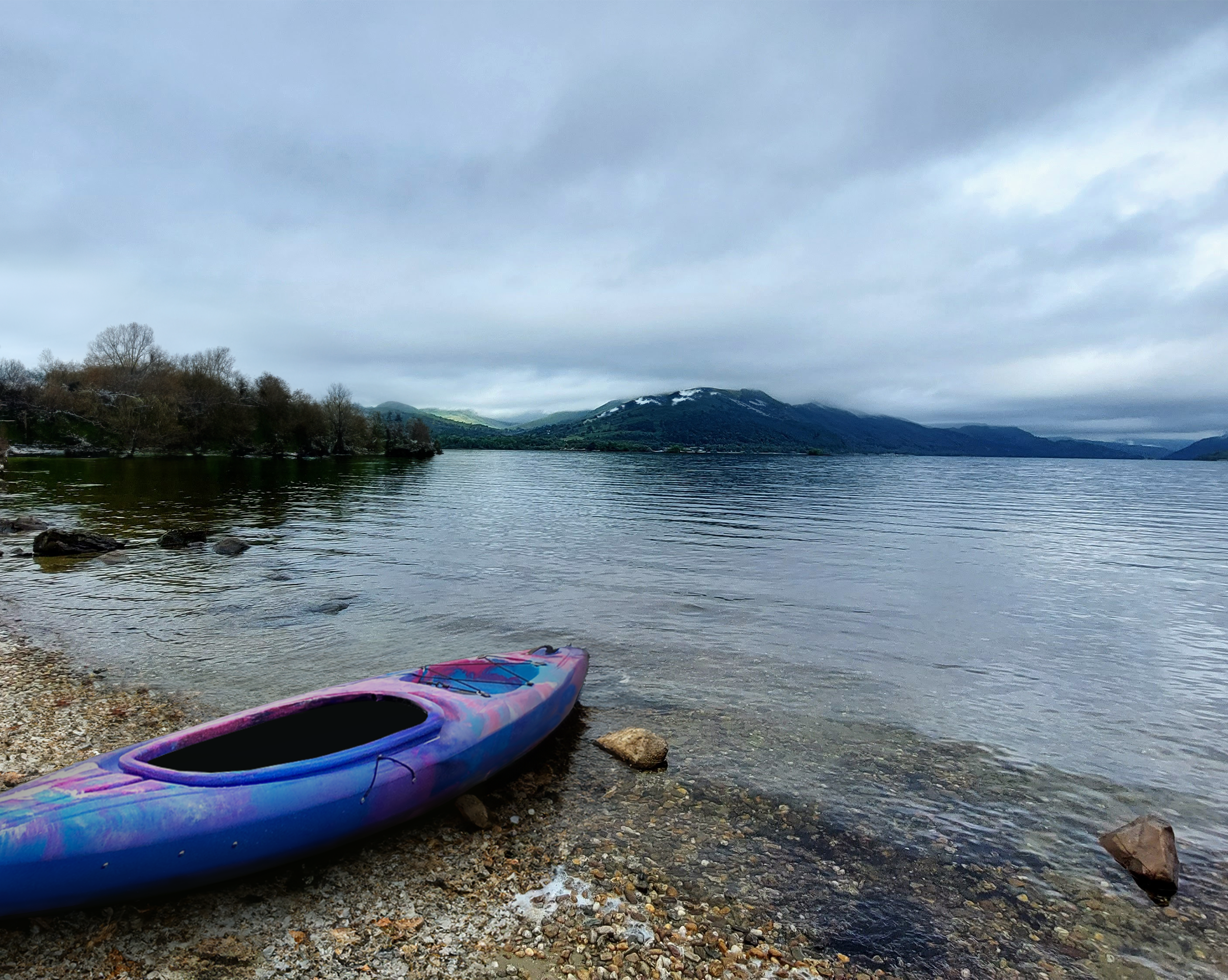While canoeing or kayaking on a warm summer's day is undeniably enjoyable, there's a unique and captivating charm to embarking on water adventures during the winter months. The crisp air, serene landscapes, and the promise of a warm drink by the fire after your journey make winter paddling an unforgettable experience. In this article, we've curated a list of ten exceptional canoe and kayak routes that shine during the winter season. These routes offer stunning winter beauty and are manageable within the limited daylight hours, ensuring a memorable experience. Don't let the cold deter you; pick up your paddle, scrape the ice off your car, and embark on these remarkable winter water adventures.
- Derwent Water, Cumbria

The Lake District is a year-round haven for canoeing and kayaking, with its winter charm equally enticing as its summer splendour. Paddling around Derwent Water, starting and ending in Keswick, is particularly enjoyable on a cold day. This route allows you to explore numerous islands, some of which still house the remnants of small buildings. For a unique twist, head towards the mouth of the River Derwent on the southeast shore. Keep an eye out for a cluster of islands marking the delta formed by the confluence. You can usually paddle far upstream along the marshy river before the flow becomes too strong.
Several launch points are available around the lake, but if you're in Keswick and eager to get on the water swiftly, head to the launch at the end of Lake Road. Alternatively, if you're camping at the Keswick Camping and Caravan Club on the north bank, you can start your paddle right there.
- The River Tees
The River Tees, located in the Pennines, is a favourite among paddlers from the northeast and beyond. Thanks to its fun yet approachable nature and consistently good winter water levels, the River Tees is a popular choice for clubs and guided groups of beginners. It boasts stunning river geography, including the awe-inspiring High Force waterfall, which is best admired from below. This section of the Tees offers a grade 2/3 pace with plenty of waves and holes for play, along with a notable rapid called the 'Dog's Leg' about halfway down. The Bernard Castle to Winston stretch, downstream of Low Force, is ideal for beginners, featuring 12 kilometres of mainly grade 3 rapids and plenty of play waves.
- The North Norfolk Coast

The North Norfolk coastline is a hidden gem for sea kayaking. While tides can be challenging, careful planning allows for a delightful experience. The area offers numerous great beaches for launching your kayak, with Brancaster being particularly convenient when the tide is in, providing easy access and parking. This coastline is rich in birdlife and unique 'barrier coast' formations, offering abundant opportunities for exploration. Although East Anglian winters can be brisk, the area's beauty remains constant, and you can find charming tea shops, bistros, pubs, and restaurants to retreat to after your coastal paddle.
- The Norfolk Broads

The Norfolk Broads, a wetland area with National Park status, is a global ecological treasure. Its vast network of rivers, broads (shallow lakes), fens, and marshes offers over 200 kilometres of navigable waterways. The Broads provide a unique and magical experience when explored by canoe or kayak, allowing you to fully appreciate the abundant wildlife and scientific significance of the area. Norfolk’s low annual rainfall and picturesque winter scenes make it an appealing destination for winter paddling. The Broads offer endless opportunities for exploration, with countless rivers, channels, broads, and secluded channels to discover.
- The River Thames
The River Thames, running from Gloucestershire through various counties to Teddington Lock, offers diverse paddling experiences year-round. One ideal winter trip is the Swift Ditch Loop starting from Abingdon, Oxfordshire. A council car park near the supermarket in the town centre provides easy access to a millstream that flows down to the river. Paddling upstream from the weir and lock towards Oxford, you can reach the entrance to Swift Ditch, the old course of the Thames before its diversion. The Ditch offers a narrow, tree-lined, and often-overgrown paddle adventure. It rejoins the Thames downstream of Abingdon town centre. The loop takes 2-3 hours to complete, and there are numerous pubs and cafes near the take-out to warm up afterward.
Thames Weirs
The Thames is dotted with fantastic play spots in the form of weirs that run reliably throughout the winter. Some notable weirs include Abingdon, Hurley & Hambleden, Boulters, Chertsey, Shepperton & Sunbury, each offering unique characteristics and challenges.
NB: Paddling weirs can be hazardous. It’s essential to have proper knowledge and skills when navigating these features. Weirs that provide freestyle fun can become dangerous at higher water levels.
- The Dart Loop
The Loop section of the River Dart in Devon is an excellent destination for beginners and club paddlers. Set against the stunning Dartmoor backdrop, the Loop offers a delightful six-and-a-half-kilometre journey from New Bridge to the take-out. It presents boulder gardens, play waves, and 'pool drop' style rapids suitable for scouting, walking, or running multiple times. Notable highlights include 'The Washing Machine,' 'Lovers' Leap,' 'Triple Drop,' and 'Spin Dryer.' These features introduce you to various types of rapids and skills required on whitewater rivers. The Loop serves as an ideal training ground for UK-style kayaking, offering both scenic beauty and exciting rapids. After your paddle, warm up at the River Dart Country Park's fully stocked bar and restaurant, with heated changing facilities available for guests.
- Cardiff International White Water Centre
he entirety of the Wye Valley attracts huge numbers of visitors on account of how stunningly beautiful it is and the walking opportunity it offers, but it is also a hugely popular destination for canoeists and kayakers. The Wye’s Upper (the last 8-17km down to the town of Rhayadar, depending on how long a trip you’d like) and Middle (the town of Builth Wells down to the town of Boughrood) sections are both excellent day trips, which largely hover between grades 2 and 3 whitewater. One of the most year-round popular sections is that which goes from the 300m Symonds Yat rapid located in the Welsh /English border area and Monmouth. Very busy in summer, but quite a bit quieter in winter this section has been described by many as one of the finest touring rivers in the UK.
The best place to start is the car park next to the caravan site in Symonds Yat, where a nominal launch fee is payable. You are almost immediately upon the rapid, which is entry level and nothing to worry about, but is nonetheless easily portage/scoutable from the bank. From here the next 10km or so down to Monmouth is completely flat and very beautiful and can easily be completed within two hours. Egress at some concrete steps on river right. There are plenty of hot chocolate-serving establishments to be found in Monmouth to warm the soul after a wintry paddle, or even something stronger if you’re looking for it!
- The River Wye
For those cold weekends with no rain to replenish rivers, a visit to a whitewater course is an excellent option. Cardiff's international-standard whitewater centre in Wales is perfect for winter whitewater kayaking. Publicized 'park and play' sessions allow you to hop on the course at designated times, featuring a variety of waves and holes suitable for beginners to refine their skills and have a great time. Whitewater courses are well-equipped with cafes, making it convenient to warm up after paddling. The nature of artificial courses allows you to choose shorter runs.
- The Pembrokeshire Coast

Pembrokeshire in Southwest Wales was the UK’s first ‘Area of Outstanding Natural Beauty’ and is home to the UK’s only coastal National Park. For the visiting sea kayaker, the area really does have everything you could wish for stunning beaches mixed with imposing sea cliffs, peaceful estuaries and, for when you get more experienced, even island crossing and circumnavigations.
Pembrokeshire is an ideal year-round sea kayaking destination: due to its dramatic and rugged geography there are plenty of sheltered inlets and bays to dip your paddle in.
- The Great Glen

What better way of spending a few days that crossing Scotland in your canoe than passing over misty lochs, historic castles and magnificent hills. A combination of natural lochs and man-made waterway the Caledonian Canal this has long been a popular multi-day trip with open canoeists and kayakers.
Embarking on the Great Glen canoe trail is always a rewarding experience. With a plethora of paddler-friendly facilities, planning your journey is a breeze, thanks to the comprehensive information on the website. Simply obtain a free license from the Great Glen Canoe Trail website, and you're all set for an adventure at any time.
Sensible Precautions
Paddling in the winter requires taking several safety precautions to ensure a safe and enjoyable experience:
Dress appropriately: Wear purpose-designed dry suits over suitable thermal layers. Always wear a personal flotation device.
Have a quick exit route in place if someone gets too cold due to accidental dunking.
Carry spare dry, warm clothing and provisions, including thermos flasks with a hot drink.
Avoid paddling alone and inform someone about your plans and location.
Monitor the weather forecast and be vigilant for deteriorating conditions while on the water.
Winter paddling can be an exhilarating experience if the necessary safety measures are taken. So, prepare, bundle up, and enjoy the beauty of the UK's waterways during the colder months.

